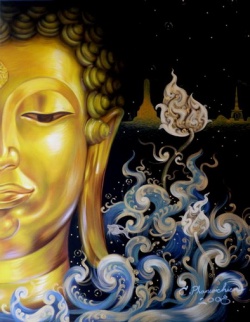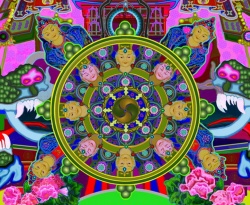Difference between revisions of "Supreme Patriarch of Cambodia"
| Line 12: | Line 12: | ||
Between 1855 and 1981, there were two [[Supreme Patriarchs]] in the {{Wiki|Kingdom}} of [[Cambodia]]: one for the [[Cambodian]] branch of the [[Thai]] [[Dhammayuttika Nikaya]] order, and one for the [[Maha Nikaya]]. In 1981, under the supervision of the Vietnamese-backed People's {{Wiki|Republic}} of Kampuchea, [[Venerable]] {{Wiki|Tep Vong}} was elected [[Supreme Patriarch]] of a new, unified [[sangha]] modelled on the [[Vietnamese Theravada Buddhist Sangha Congregation]]. | Between 1855 and 1981, there were two [[Supreme Patriarchs]] in the {{Wiki|Kingdom}} of [[Cambodia]]: one for the [[Cambodian]] branch of the [[Thai]] [[Dhammayuttika Nikaya]] order, and one for the [[Maha Nikaya]]. In 1981, under the supervision of the Vietnamese-backed People's {{Wiki|Republic}} of Kampuchea, [[Venerable]] {{Wiki|Tep Vong}} was elected [[Supreme Patriarch]] of a new, unified [[sangha]] modelled on the [[Vietnamese Theravada Buddhist Sangha Congregation]]. | ||
| − | After the signing of the {{Wiki|Paris Peace Accords}} in 1991, [[King]] [[Wikipedia:Norodom Sihanouk|Norodom Sihanouk]] appointed [[Venerable]] [[Bour Kry]] as [[Supreme Patriarch]] of [[Dhammayuttika Nikaya]]. Today, the two orders are each headed by their own [[patriarch]], unlike in [[Thailand]] where only one [[Supreme Patriarch]] heads both orders. The {{Wiki|Constitution}} of [[Cambodia]] provides a seat on the | + | After the signing of the {{Wiki|Paris Peace Accords}} in 1991, [[King]] [[Wikipedia:Norodom Sihanouk|Norodom Sihanouk]] appointed [[Venerable]] [[Bour Kry]] as [[Supreme Patriarch]] of [[Dhammayuttika Nikaya]]. Today, the two orders are each headed by their own [[patriarch]], unlike in [[Thailand]] where only one [[Supreme Patriarch]] heads both orders. The {{Wiki|Constitution}} of [[Cambodia]] provides a seat on the {{Wiki|Royal Council of the Throne}} to both [[Supreme Patriarchs]], thus giving each a say in the selection of the [[Cambodian]] sovereign. |
In 2006, {{Wiki|Tep Vong}} was elevated to the {{Wiki|status}} of [[Great Supreme Patriarch]], while [[Venerable]] [[Non Nget]] was subsequently elevated to [[Supreme Patriarch]] of the [[Maha Nikaya]]. {{Wiki|Tep Vong}} is the [[first monk]] in 150 years to bear the title of [[Great Supreme Patriarch]]. | In 2006, {{Wiki|Tep Vong}} was elevated to the {{Wiki|status}} of [[Great Supreme Patriarch]], while [[Venerable]] [[Non Nget]] was subsequently elevated to [[Supreme Patriarch]] of the [[Maha Nikaya]]. {{Wiki|Tep Vong}} is the [[first monk]] in 150 years to bear the title of [[Great Supreme Patriarch]]. | ||
Revision as of 13:08, 21 August 2014
The Supreme Patriarch of Cambodia (Pāḷi: Sangharāja; Khmer: សម្តេចព្រះសង្ឃរាជ, pronounced sɑmdac preah sɑŋ riec) is the de facto leader of Buddhism in Cambodia.
Titles
The titles for the Cambodian Supreme Patriarchs are derived from Pali. The full official title of the Supreme Patriarch of the Maha Nikaya is Samdech Preah Sumedhādhipati (Khmer: សម្តេច ព្រះ សុមេធាធិបតី); sumedhādhipati means 'wise lord'. In letters with King-Father Norodom Sihanouk, the following title is used for the Great Supreme Patriarch Tep Vong: Samdech Preah Agga Mahā Sangharājādhipati (Khmer: សម្តេច ព្រះ អគ្គមហាសង្ឃរាជាធិបតី); which is translated as 'foremost great supreme patriarch leader'.
The full official title of the Supreme Patriarch of the Dhammayuttika Nikaya is Samdech Preah Aphiserei Sukonthea Mohasangreacheathipadei (Abhisirī Sugandhā Mahāsangharājādhipati) (Khmer: សម្តេច ព្រះ អភិសិរី សុគន្ធា មហាសង្ឃរាជាធិបតី). This title means 'Of Higher Merit and Pure Virtue, Great Supreme Patriarch Leader'. In letters with King-Father Sihanouk, an abbreviated title is used in the valediction: Samdech Preah Sangreach (Khmer: សម្តេច ព្រះ សង្ឃរាជ).'
History
Between 1855 and 1981, there were two Supreme Patriarchs in the Kingdom of Cambodia: one for the Cambodian branch of the Thai Dhammayuttika Nikaya order, and one for the Maha Nikaya. In 1981, under the supervision of the Vietnamese-backed People's Republic of Kampuchea, Venerable Tep Vong was elected Supreme Patriarch of a new, unified sangha modelled on the Vietnamese Theravada Buddhist Sangha Congregation.
After the signing of the Paris Peace Accords in 1991, King Norodom Sihanouk appointed Venerable Bour Kry as Supreme Patriarch of Dhammayuttika Nikaya. Today, the two orders are each headed by their own patriarch, unlike in Thailand where only one Supreme Patriarch heads both orders. The Constitution of Cambodia provides a seat on the Royal Council of the Throne to both Supreme Patriarchs, thus giving each a say in the selection of the Cambodian sovereign.
In 2006, Tep Vong was elevated to the status of Great Supreme Patriarch, while Venerable Non Nget was subsequently elevated to Supreme Patriarch of the Maha Nikaya. Tep Vong is the first monk in 150 years to bear the title of Great Supreme Patriarch.
Partial list of Cambodian patriarchs
Dien (1823–1913) (Maha Nikaya)
Saukonn Pan (1855–1894) (Dhammayuttika Nikaya)[5][6]
Chuon Nath (1948–1969) (Maha Nikaya)[7]
Huot Tat (1969–1975) (Maha Nikaya)[7]
Ghosananda (1988–2007) (Maha Nikaya)[8]
Tep Vong (1981–present) (Unified Sangha 1981–1991, Maha Nikaya 1991–2006, Grand Supreme Patriarch 2006–present)
Bour Kry (1991–present) (Dhammayuttika Nikaya)
Non Nget (2006–present) (Maha Nikaya)

